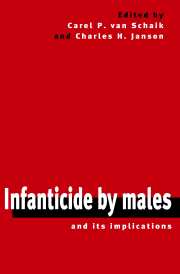Book contents
- Frontmatter
- Contents
- List of Contributors
- Foreword
- Infanticide by males: prospectus
- Part I Introduction
- Part II Infanticide by males: case studies
- 4 Infanticide in red howlers: female group size, male membership, and a possible link to folivory
- 5 Infanticide in hanuman langurs: social organization, male migration, and weaning age
- 6 Male infanticide and defense of infants in chacma baboons
- 7 Infanticide by males and female choice in wild Thomas's langurs
- 8 The evolution of infanticide in rodents: a comparative analysis
- 9 Infanticide by male birds
- Part III Behavioral consequences of infanticide by males
- Part IV Infanticide by females
- Part V Conclusion
- References
- Species index
- Subject index
8 - The evolution of infanticide in rodents: a comparative analysis
Published online by Cambridge University Press: 04 November 2009
- Frontmatter
- Contents
- List of Contributors
- Foreword
- Infanticide by males: prospectus
- Part I Introduction
- Part II Infanticide by males: case studies
- 4 Infanticide in red howlers: female group size, male membership, and a possible link to folivory
- 5 Infanticide in hanuman langurs: social organization, male migration, and weaning age
- 6 Male infanticide and defense of infants in chacma baboons
- 7 Infanticide by males and female choice in wild Thomas's langurs
- 8 The evolution of infanticide in rodents: a comparative analysis
- 9 Infanticide by male birds
- Part III Behavioral consequences of infanticide by males
- Part IV Infanticide by females
- Part V Conclusion
- References
- Species index
- Subject index
Summary
Introduction
We simultaneously know more about the proximate causes of infanticide in rodents and less about its adaptive consequences and evolution than in any other taxon. Rodents are the largest mammalian order with over 440 genera and 2021 of the 4629 described species (Musser & Carleton 1993; Wilson & Reeder 1993). Infanticide by either or both males and females may be found in 46 species from 22 genera in 3 rodent groups (see below). A number of previous reviews illustrate the detailed understanding of proximate causation, development, and function gained by studying infanticide in rodents (Sherman 1981; Brooks 1984; Elwood & Ostermeyer 1984; Huck 1984; Labov 1984; Svare et al. 1984; vom Saal 1984; Labov et al. 1985; Trulio 1987; Elwood 1992; Elwood & Kennedy 1994; Ebensperger 1998a). In this review, I take a slightly different approach to study the evolution of infanticide in rodents. I first use the taxonomic distribution of infanticide by males and infanticide by females along with available phylogenetic evidence to parsimoniously reconstruct the evolution of infanticide by males, infanticide by females, and a potential female response to infanticide by males – male-induced pregnancy termination (Bruce effects; Bruce 1960). Then, using these evolutionary reconstructions, I test specific functional hypotheses about infanticide.
A thumbnail sketch of infanticide in rodents
Rodents provide some of the richest information about infanticide because studies of the proximate causation of infanticide are integrated with studies designed to document ultimate function.
- Type
- Chapter
- Information
- Infanticide by Males and its Implications , pp. 178 - 197Publisher: Cambridge University PressPrint publication year: 2000
- 27
- Cited by

